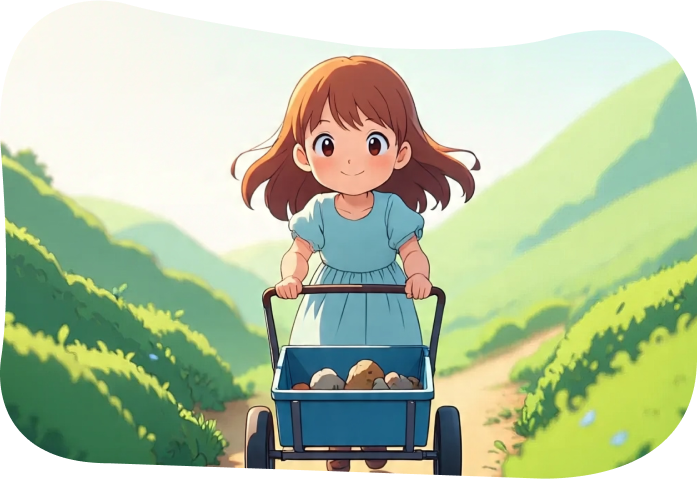
Have you ever paused to look at a rock, a button, or a crumpled leaf your child eagerly hands you—and then brushed it off as unimportant? To you, it might be just a rock. But to them, it could be a symbol of something far more powerful. In Karen R. Sullivan’s touching children’s book The Blue Wagon, readers are invited into a world where a child’s “treasures” speak volumes—about imagination, emotional weight, and the need to be understood. This is not just a story about a child and some rocks. It’s a journey into the quiet places of a child’s heart—and a mirror for the adult soul.
Six-year-old Heather is on a mission: to find treasures and fill her beloved blue wagon. Along her path, she picks up rocks that sparkle, rocks with swirls, and even ones filled with holes. Each one is special in its own way. They aren’t valuable in the traditional sense, but they are precious to her. At first, her adventure is light and joyful. But as her wagon fills, it becomes heavier, and Heather becomes tired. Without even realizing it, she begins to carry a weight that isn’t just physical—it’s emotional. This is where the book begins to shift from a simple tale to a layered message.
One of the most significant truths Karen R. Sullivan conveys is this: children carry burdens, too. Heather’s blue wagon is a metaphor. Her rocks, though simple, represent thoughts, feelings, and experiences—things she might not know how to talk about, but still feels strongly. When Heather meets Mr. Wiggledimp, a kind and gentle neighbor, he gives her a painted rock from his own childhood. It’s more than a gift; it’s a moment of connection, of shared stories across generations. And when Heather finds a fossil-filled rock, she learns that even things with holes—things others might throw away—can hold great meaning. As she heads home, struggling with the increasing weight of her wagon, the parallel to emotional burdens becomes clear: what we carry with us, even as children, shapes our journey.
Later, Heather’s mother, tired and preoccupied, tells Heather to wait before showing her the treasures. At first, Heather is disappointed. But when her mother finally takes time to listen, she explains something powerful: adults have “rocks” too. Not in wagons, but in their minds and hearts. These rocks are called worry. That simple explanation hits home. Children might not understand the word “anxiety” or “responsibility,” but they do understand heaviness. Through this moment, Sullivan teaches that emotional awareness can start early—and that being honest with children, in age-appropriate ways, helps them feel seen.
One of the most powerful scenes in The Blue Wagon is when Heather questions whether she should keep a strange, hole-filled rock. It doesn’t look pretty, and she almost leaves it behind. But she remembers something she heard: “One man’s trash is another man’s treasure.” She decides to take it anyway. Later, Mr. Wiggledimp tells her it’s full of fossils—marks from millions of years ago, maybe even from the time of dinosaurs. Suddenly, the “ugly” rock becomes the most valuable of all. This moment teaches an important lesson: we shouldn’t judge what our children hold dear. That strange drawing, that random trinket, that “ugly” rock—they all mean something to the child who picked them up. They represent a memory, a feeling, a part of their developing identity.
Heather’s mother, though tired and distracted at first, eventually makes time to look at her daughter’s treasures. And when she does, she doesn’t rush through it—she listens, asks questions, and appreciates what she sees. This small act is incredibly important. As the author shared in her questionnaire, one of her key intentions is to show the value of keeping your word to children. When you promise to show up, to listen, to care—it teaches them they matter. It teaches them to trust. While The Blue Wagon is written for children, its deeper message is meant for the grown-ups reading alongside them. Sullivan delicately weaves in spiritual undertones, drawing on values like compassion, presence, and emotional honesty—without ever being heavy-handed. Mr. Wiggledimp becomes more than a kind neighbor. He symbolizes the wisdom of age, the power of storytelling, and the quiet kindness the world needs more of. His simple act of sharing a painted rock echoes a deeper truth: our experiences, no matter how small, are worth passing on.
At the end of the day, The Blue Wagon leaves us with a lingering question: what are you carrying? Adults often ignore their emotional burdens, pushing through worry and stress without reflection. But just like Heather learned from her own experience, these weights eventually slow us down. The book gently encourages readers of all ages to pause, reflect, and maybe even unburden themselves—by talking, by connecting, by noticing. The next time your child offers you a rock, a drawing, or a toy with shining eyes and a proud smile—pause. Ask them about it. Treasure it, not because it’s valuable in the world’s eyes, but because it’s valuable to them. Karen R. Sullivan’s The Blue Wagon reminds us that to honor a child’s treasure is to honor the child themselves. And sometimes, in doing so, we reconnect with the child we once were.
Quick Links
Useful Links
Copyright © 2025 Karen Sullivan. All Rights Reserved.